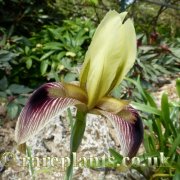Description
Iris afghanica is one of the most fabulous of the Regelia section and indeed, one of the most striking of Afghani plants in cultivation.
Originally found by Rear Admiral Paul Furse and his wife Polly in Afghanistan in 1964 on the northern side of the Salang Pass on steep rocky slopes at up to 3,300m. It was re-found by them in 1966 at which point is was recognised as a new species. It was subsequently described by Per Wendelbo (Notes Roy. Bot. Gard. Edinburgh 31: 338 1972).
The plant has slender, quite long, usually sickle-shaped, blue-green leaves which sit below a superb flower about 9cm across. This has falls with a white to pastel cream ground colour, however they are so heavily overlaid with purple-brown veining that you can easily not see that they are whitish. The veining surrounds a central purple-brown patch in the centre of each fall, which itself has a white beard, in which the hairs are individually tipped with purple. Near the base of the falls, the veining becomes broken into dotted lines. In total contrast the strongly upright standards are a lovely, unveined, primrose yellow and they too have a little beard at their base, but one of yellow hairs.
The species is simply a stunner, worth any amount of trouble to grow. In the wild, in northern Afghanistan, Iris afghanica experiences hot summers and very cold winters. It is likely that the area where it grows is also dry in summer, however to translate this to cultivational requirements you must remember that the rhizomes will have protection from desiccation by the heavy clay soils that it naturally grows in. Heavy clay as a compost in the UK is death to this species, so you will need to simulate the conditions it experiences, not the climate and soil it lives in! In the UK it needs to be kept under glass and treated really as an alpine over winter, but given abundant fertilisation and water when it grows in spring, then dry off over summer. I suggest a loam-based compost with the provision of excellent drainage; rounded river gravel or limestone chippings (dolomite limestone for perfection). I also incorporate tufa and pumice within my composts for the more demanding Regelia and Oncocyclus species of Iris.
Iris afghanica is not difficult, given an understanding of its needs but despite its extreme beauty it has remained a rare plant in cultivation. It may not be a plant for the average gardener but at least one other reason for this scarcity is that plants will not set seed with their own pollen and as only a few plants were originally introduced, so many of the survivors are clonal. Thus there is not even a guarantee that your friend’s plant will pollinate your own. Ours are clonal and originated with Janis Ruksans, many years ago.
Added to our listing, August 2017 however this is very very scarce now and I cannot begin to speculate when, of IF, we will have it again.






